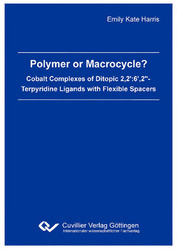| Areas | |
|---|---|
| Serie de libros (96) |
1378
|
| Nachhaltigkeit |
3
|
| Gesundheitswesen |
1
|
| Letra |
2364
|
| Ciencias Naturales |
5406
|
| Matemática | 229 |
| Informática | 319 |
| Física | 980 |
| Química | 1363 |
| Geociencias | 131 |
| Medicina humana | 243 |
| Estomatología | 10 |
| Veterinaria | 108 |
| Farmacia | 147 |
| Biología | 835 |
| Bioquímica, biología molecular, tecnología genética | 121 |
| Biofísica | 25 |
| Nutrición | 45 |
| Agricultura | 1004 |
| Silvicultura | 201 |
| Horticultura | 20 |
| Ecología y conservación de la tierra | 148 |
| Ciencias Ingeniería |
1793
|
| General |
98
|
|
Leitlinien Unfallchirurgie
5. Auflage bestellen |
|
Erweiterte Suche
Polymer or Macrocycle? Cobalt Complexes of Ditopic 2,2':6',2"- Terpyridine Ligands with Flexible Spacers (Tienda española)
Emily Kate Harris (Autor)Previo
Indice, Datei (53 KB)
Lectura de prueba, Datei (160 KB)
The reaction of transition metal ions with ditopic ligands containing two 2,2’:6’,2"-terpyridine units linked by flexible spacers can give metallosupramolecular polymers, discrete metallomacrocycles or mixtures of the two. The outcome of the coordination depends on the precise reaction conditions as well as the nature of the spacer and the transition metal salt.
This thesis is concerned with the reaction between cobalt(II) salts and bis(2,2’:6’,2"-terpyridine) ligands in which the metal-binding domains are linked by flexible oligo(ethylene glycol) spacers. An initial study of the ligands and several model mononuclear bis(2,2’:6’,2"-terpyridine)cobalt(II) and (III) complexes gave some insight into the solid state and solution properties of these systems, and PGSE NMR spectroscopy was found to be a useful tool for determination of the size of both the ligands and the cobalt(III) complexes in solution. The reaction of the ditopic ligands with cobalt(II) acetate tetrahydrate in pure alcohol was found to cause the decomposition of the ligand and the formation of a mononuclear bis(4’-alkoxy-2,2’:6’,2"-terpyridine)cobalt(II) complex. This reaction was extended to monotopic 4’-substituted-2,2’:6’,2"-terpyridines and can be considered as a reaction giving rise to polymer end-capping units, thus influencing the final outcome of the coordination. The effect of the anion on the coordination was considered further, and the speciation of mono- and bis(2,2’:6’,2"-terpyridine)cobalt(II) complexes in solution was investigated using the 4’-methoxy-2,2’:6’,2"-terpyridine ligand. The product mixtures were found to depend heavily on the anion, solvent and initial ratio of ligand to metal salt. Similar behaviour was observed for a model ditopic ligand. The presence of the mono(2,2’:6’,2"-terpyridine)cobalt(II) complexes within a system containing the ditopic ligands would also provide polymer end-capping units, influencing the speciation of these mixtures. Finally, a detailed study of the product mixtures obtained from the reactions of the ditopic ligands with cobalt(II) salts revealed a complex dependence of the speciation of many bis(2,2’:6’,2"-terpyridine)cobalt(II) complexes on the ligand, anion, solvent, concentration and other seemingly minor reaction parameters. Using the PGSE NMR spectroscopic technique, the sizes of some of the metallomacrocyclic species present in the equilibrium mixtures could be determined. These measurements were in excellent agreement with X-ray crystallographic data. Analysis of initial product mixtures using the same technique suggested that the initial kinetic products of the complexation are significantly larger species.
| ISBN-10 (Impresion) | 3869554118 |
| ISBN-13 (Impresion) | 9783869554112 |
| ISBN-13 (E-Book) | 9783736934115 |
| Idioma | Inglés |
| Numero de paginas | 268 |
| Edicion | 1 Aufl. |
| Volumen | 0 |
| Lugar de publicacion | Göttingen |
| Lugar de la disertacion | Universität Basel |
| Fecha de publicacion | 28.07.2010 |
| Clasificacion simple | Tesis doctoral |
| Area |
Química
|








